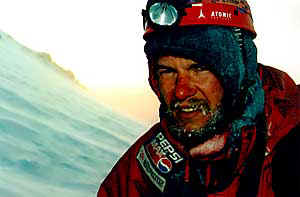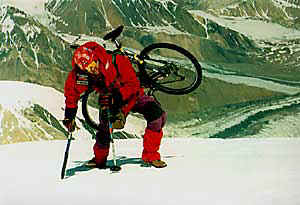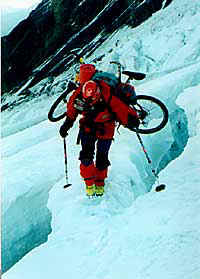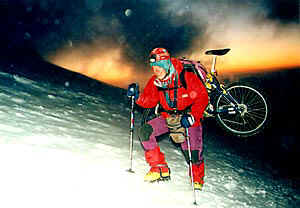Riding Highest.
|

Tomasz Swinarski
|
Tomasz Swinarski comes from Kraków in Poland.
He is now working in London, where he was interviewed by Ivan Viehoff. Tomasz Swinarski
believes that he may have ridden a bicycle at a higher altitude than anyone else. And
first he had to take the bicycle there, entirely under his own power.
What is amazing is that this was not a feat born of experience, but rather of
determination and ambition. |
| Tomasz is a strong all-round adventure sportsman. He took up
mountain triathlon, a racing discipline involving mountain-bike, rock-climbing and
white-water kayaking. He gained his enthusiasm for off-road cycling on the steep tracks of
his native southern Poland. Here the hills and woods, although only foothills to the
jagged Tatra along the Slovak border, are ideal mountain bike terrain. He tasted the
pleasures of wilderness in a couple of exciting expeditions. He went awol from a white
water expedition in Rwanda and Kenya to climb Kilimanjaro. Scarcity of funds pushed him to
do this by the back door, with neither a Tanzanian visa nor a trekking permit. Later he
climbed Mount Elbrus in the Caucasus. The truth is that Elbrus and Kilimanjaro are
trekking peaks. Elbrus calls for ice axe and crampons, but nothing too technical. In this
context, we can see the risk in Tomasz's next idea. |

On the way up.
|
| He wanted to cycle down from a really high mountain, higher than
he had ever been. He had to wait three years for the chance to arrive. The opportunity
came when friends asked him whether he might be interested in climbing Pik Lenin in the
Pamirs. Indeed he was, but he wished to take his bike with him. I remain astonished that
the invitation was not withdrawn. Amazingly he managed to get sponsorship for all his
equipment, both for mountaineering and cycling. Ten years ago one could describe Pik Lenin
as the third highest mountain in the Soviet Union. Today it lies on the border of
Kyrgyzstan and Tajikistan, new states of central Asia. It is a mountain on which many
Soviet mountaineers cut their teeth. The simplest route is not overly technical. But at
7,134m it can hardly be said to be a pushover in mountaineering terms. |
| Without any prior practice on lesser peaks, Tomasz wanted to ride
his bicycle at over 7,000m. He prepared his bicycle for the snow and ice by fixing several
hundred steel bolts into his tyres, protruding about 8mm. He packed it in a box, and with
his 10 companions set off to Kyrgyzstan, an overland train journey of six days. They hired
a truck to take them to the dour huts of Onion Field, the Kyghyz mountaineering base on
the northern flank of the mountain. I once went there myself. It is a typical central
Asian scene of yak pastures and high mountains, at an altitude of about 3,800m.
|

Crossing a crevasse.
|
| Pik Lenin is no Matterhorn. From here you see a daunting wide
mountain nearly filling the view. A long, nearly level ridge forms the sky-line, wider and
flatter even than Denali. The peak itself seems irrelevant in comparison with the bulk of
the mountain. First they went through a series of acclimatisation climbs. These are an
essential part of any high mountain climb, as they permit a later rapid assault on the
final goal. So, without the bicycle, a group of four set off for some lesser peaks in the
area. The last was Pik 19, at 5,900m already higher than Tomasz had previously climbed.
But Tomasz had grander plans already. |
| At the second camp on Pik 19, Tomasz suggested carrying on
to a direct assault on Lenin. A couple of days before, he had spotted a route on someone
else's map, and made a sketch of it. Tomasz's enthusiasm took his reluctant companions
with him. Soon they had burnt their bridges, when the warm sun turned their retreat route
into an avalanche risk. With only the sketch map, they almost got lost on Pik 19, and the
next day on Spartak (6,200m). Some difficulties nearly undid them. Tomasz fell through a
snow bridge into a shallow crevasse, but had little difficulty climbing out. Technical
pitches consumed another day for little progress. From a 5,800m col they finally started
climbing a steep ridge which took them directly onto the long, long summit ridge at around
7,000m. Seemingly almost there, but with food running out, they determined to keep going
all night over the endless false summits. |
| The altitude made it too much effort and they stopped. Tomasz was
now ahead of his companions and bivouacked in a snow hole. On regrouping the next morning,
they abandoned the attempt and took advantage of a direct descent route. Tomasz speared
himself with his crampons while sliding down snow slopes, but was not badly injured. Now
all that remained was to climb all the way back up again - with the bicycle. He would
climb with a single partner, his brother-in-law. Using the straightforward direct route,
it is normal to establish four camps. Bringing his bicycle to camp one at 4,200m, he could
wheel and occasionally ride. From here on up, the bicycle was attached to the back of his
rucksack as he climbed over steep slopes, ice, snow, and around crevasses. The bicycle was
kept fully assembled, since he felt it would be too cold higher up to risk re-assembly
work. |

Twilight climbing.
|
| On his way to camp two, Tomasz suffered with the heavy weight of
his pack. He managed to leave some luggage here, and they proceeded over ice and snow to
camp three at 6,100m. But he still had too much to carry. He was sinking dangerously into
snow that had borne the weight of his partner. He took the risk of leaving even more - his
bike tools, some thick clothing, and amazingly his crampons. With excellent weather, they
made a summit attempt from the third camp, but time ran short. Tomasz was able to leave
his bicycle high on the mountain while they returned to camp three in deteriorating
weather. The next day they walked through fresh snow to establish camp four.
|
| Climbing on from there, it transpired that he had left his bicycle
only minutes from the summit. So soon he was able to experience the ecstasy of making the
top. And so into the saddle. Tomasz says the worst of it was the steepness. The metal
studs in his tyres were essential for traction. His hydraulic brakes proved up to the
conditions - almost. At times it was still difficult to control the bicycle to a safe
speed. Tomasz was still quite near the top when he lost control over a curve in the ridge,
and ended up sliding down the snow and ice towards a crevasse. He had no ice axe to slow
himself down. The bicycle started to get caught in a soft patch. This slowed him down, but
it took a second soft patch to stop him. He felt he was acting in a Hollywood thriller,
though in truth he had not been far from death. On he rode. Frequently the front wheel
sank into patches of soft snow and he went over the handlebars. At times he had to
dismount and carry the bike. Without crampons or ice-axe, he was sometimes grateful for a
steadying hand from his companion. With a mixture of riding and walking, they made the
descent together in just two days. |



